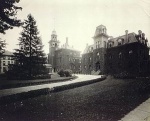Difference between revisions of "Portal:Featured Article Of The Week"
M-Explorer (talk | contribs) |
M-Explorer (talk | contribs) |
||
| Line 1: | Line 1: | ||
{{FAformat | {{FAformat | ||
| − | |Title= | + | |Title= London Psychiatric Hospital |
| − | |Image= | + | |Image= London.jpg |
|Width= 150px | |Width= 150px | ||
| − | |Body= The | + | |Body= The former London Asylum for the Insane (LAI) opened in 1870, and has transformed over the years in response to changing approaches to mental health care. In 1869 the provincial legislature appropriated $100,000 to build the London Asylum for the Insane, and 300 acres of land were purchased at $67 an acre. Older asylums at Malden and Orillia closed and were replaced by the new facility in London. The LAI was ready for occupation within 18 months of the site's purchase and its first patients arrived from Malden and Orillia in November 1870. |
| − | + | After its establishment, the LAI aimed to distinguish itself in the field of mental health care in Canada. The Asylum's first superintendent, Dr. Henry Landor, was an advocate of compassionate care, who believed in the restorative influence of a rural setting and the practical use of moral therapy. Landor encouraged the Province of Ontario to purchase of an additional 100 acres east of the original site for the erection of cottages that were intended to provide more comfortable and independent accommodation for long-term patients. | |
| − | The | + | The main building featured a number of wards for different patients. Superintendents wished to create a sense of home life for the patients, and the building featured sitting rooms, solariums and balconies where they could relax. Patients in the main building were separated into paid and free wards. Patients who were able could pay between $1.50 and $2.75 per week for more comfortable surroundings and even private rooms. However, in 1871 only 4% of patients paid any fees. |
| + | |||
| + | Male and female patients lived apart, usually in dormitory-style rooms, but there were chances to socialize. The building featured a large dining area, where patients could eat together or receive visitors, an amusement hall, where church services were held until the chapel was built in 1884, and even a library, stocked with suitable material. These leisure spaces could be used by patients who had permission to move around the Asylum without chaperones. Other patients, such as those in the North Building, had to be supervised or were confined to their wards. [[London Psychiatric Hospital|Click here for more...]] | ||
}} | }} | ||
Revision as of 05:01, 18 November 2013
Featured Article Of The Week
London Psychiatric Hospital
The former London Asylum for the Insane (LAI) opened in 1870, and has transformed over the years in response to changing approaches to mental health care. In 1869 the provincial legislature appropriated $100,000 to build the London Asylum for the Insane, and 300 acres of land were purchased at $67 an acre. Older asylums at Malden and Orillia closed and were replaced by the new facility in London. The LAI was ready for occupation within 18 months of the site's purchase and its first patients arrived from Malden and Orillia in November 1870.
After its establishment, the LAI aimed to distinguish itself in the field of mental health care in Canada. The Asylum's first superintendent, Dr. Henry Landor, was an advocate of compassionate care, who believed in the restorative influence of a rural setting and the practical use of moral therapy. Landor encouraged the Province of Ontario to purchase of an additional 100 acres east of the original site for the erection of cottages that were intended to provide more comfortable and independent accommodation for long-term patients.
The main building featured a number of wards for different patients. Superintendents wished to create a sense of home life for the patients, and the building featured sitting rooms, solariums and balconies where they could relax. Patients in the main building were separated into paid and free wards. Patients who were able could pay between $1.50 and $2.75 per week for more comfortable surroundings and even private rooms. However, in 1871 only 4% of patients paid any fees.
Male and female patients lived apart, usually in dormitory-style rooms, but there were chances to socialize. The building featured a large dining area, where patients could eat together or receive visitors, an amusement hall, where church services were held until the chapel was built in 1884, and even a library, stocked with suitable material. These leisure spaces could be used by patients who had permission to move around the Asylum without chaperones. Other patients, such as those in the North Building, had to be supervised or were confined to their wards. Click here for more...
